Do you own or work for a small business that is facing the challenge of establishing a website and Internet presence but have no idea where to start? Do you have questions about the process, expected costs, do’s and don’ts, and feasibility of website design and don’t know who, or even what, to ask? We help businesses create and maximize their online presence every day and offer this step-by-step guide as a resource to you as you consider your Internet options. In addition, we have put together an FAQ section to address some of the most frequently asked questions.

Step #1: Select & Register a Domain Name
The first step in the development of any new website is to determine what domain name you will use. Even if you are not ready to proceed with the development of a website, we recommend completing this step as soon as possible. You may find that your first choice of domain name is already taken. For that reason, it is best to find and hold one, even if you aren’t ready to go further in the process. To determine the availability of your chosen domain name and register it, you can use services like www.godaddy.com or www.networksolutions.com.
Step #2: Define Your Goals
This step is critical in creating a successful online presence—the careful articulation of your Internet goals. What do you want your web site to do for you? Websites can do many different things: business promotion, e-commerce, customer service, employee recruitment, new customer acquisition, client retention and more. Knowing what you want the website to do for your business will dictate the design and technological requirements of the website. Further, it will enable you to better communicate your expectations to the web development team.
Step #3: Do Some Research
After developing a rough sketch of your overall goals for the site, the best place to turn is the Internet itself by doing a little research. Search on Google for websites within your industry and for your competitors’ sites. By doing so, you can get great ideas and develop a better understanding of the market and your competition within it. Take lots of notes and paste URLs of example sites into your Word doc of notes, noting what you like and don’t like about each example.
Based on your work in steps two and three, you will have a good idea of the scope of your website. In order to get good estimates that match your needs, having a well-defined scope is critical. It also helps you receive apples-to-apples bids, which can be a real challenge with websites.
Step #4: Select Providers
Creating, launching, and managing a successful website requires graphic artists, web developers, and web hosting services. You may want to interview several companies to ensure that you will be receiving the level of service, design, and follow up that suits your business and its objectives. Different companies provide varying levels of services, and your best result will come from a good fit between their service offerings and your needs. Some questions that may help in your evaluation of providers include:
- What work has the company done? Request a list of URLs of web sites that they have created. Are those sites appealing to you? Is the functionality and design in line with your expectations? For links to some of our clients’ pages, Click Here.
- What do the clients of the provider say about them? Get referrals of people you can talk to. Read the online reviews for each provider. To see what some clients of dandelion marketing have to say about us, read our reviews here.
- What will the web development company do to market your new website? How will they help you get visitors, and more importantly new customers, to your site? dandelion marketing offers 20 years of SEO experience; click here to learn about our Internet Marketing Services. SEO services are not typically included in a website design proposal. If you need those services, you will want to make sure you have pricing for that as well before making your decision.
dandelion marketing works with many providers and is able to provide a seamless Internet team to you by pulling together the best providers to meet your needs. We manage the process for you so you don’t have to worry about who is doing what. To ask us specific questions, please complete the contact form by clicking here.
Step #5: Site Development
This is the time when your planning and ideas take shape. The basic stages of site development are:
- Develop a flow chart to illustrate the major sections and organization of the site.
- Create a design theme – translate the goals set in Step #2 and the image and tone of the business and brand into a design concept that includes layout, colors, and graphics.
- Sign Off on Design Components
- Build Out Web Site
- Integrate content and build out all pages
- Test the completed development site for functionality and across a variety of devices and screen sizes.
Step #6: Website Marketing
- Site Optimization: The most important factor in search engine optimization is CONTENT – lots of good quality content is your best bet when seeking search engine success. In addition, it is critical that your site use unique and descriptive title and description tags on each page within the website.
- Social Media: Create, optimize and engage with your profiles on various social media platforms. The platforms you choose need to match your customers’ habits.
- Incoming Links: Another critical site marketing tactic includes obtaining links to your site from other-related sites. These need to be good, legitimate links from quality sites that provide information and value to users. Low quality will actually hurt your site in the search engines and will never send good leads to your site. Examples of good link placements include professional organizations, chambers, other related businesses, industry blogs, news sites, and industry-specific directories.
- You may elect to boost your online presence with online advertising. This can take the form of PPC campaigns or social media advertising. These options should be considered within the larger context of your company’s marketing plan and budgeted accordingly.
- Promoting the new site in your existing marketing outlets: Finally, you will want to ensure that your site is promoted along with all your other company information in offline marketing pieces such as brochures, letterhead, advertising, business cards, signage, and company trucks/cars.
Ready to get started? Let us know how we can help!

